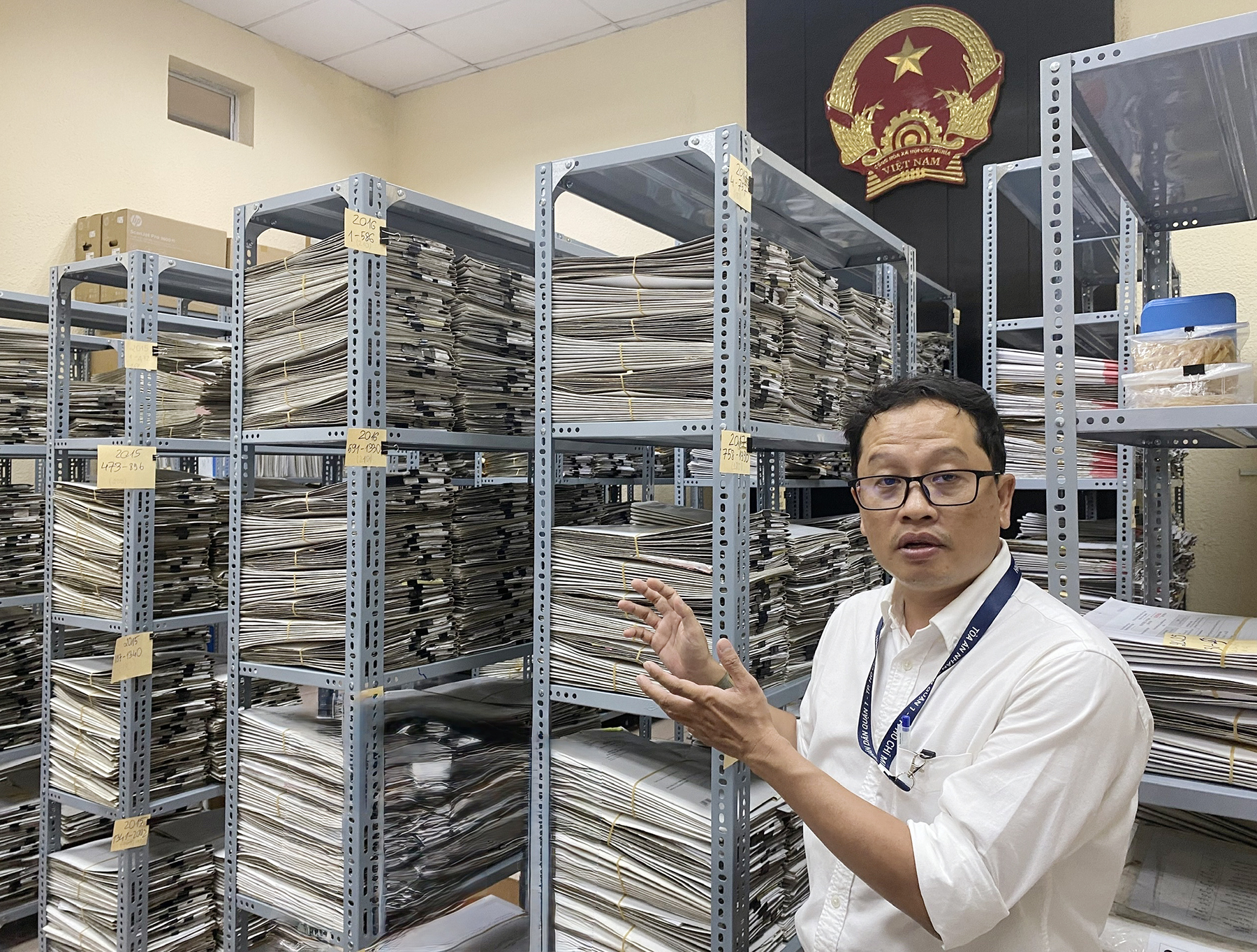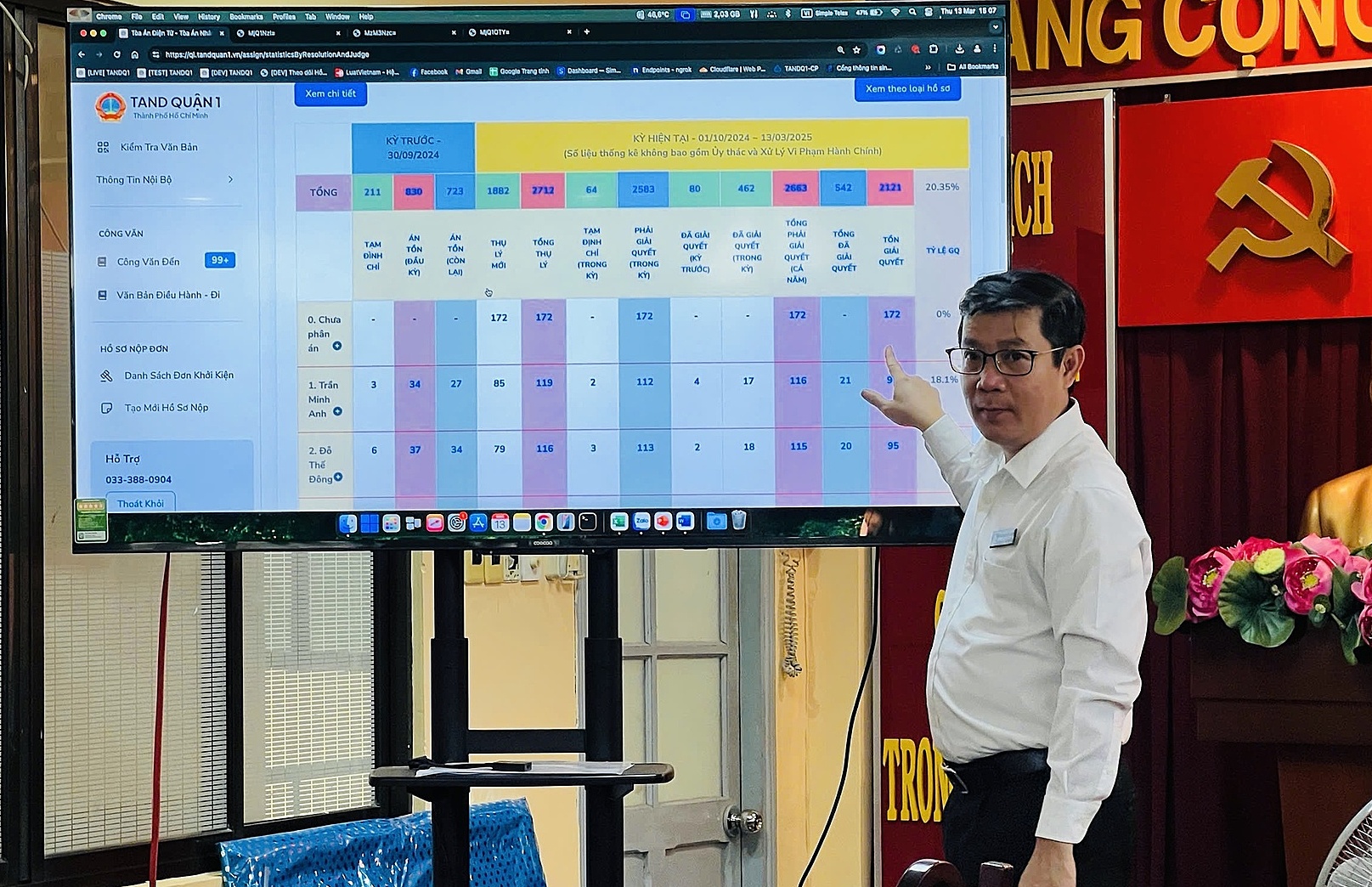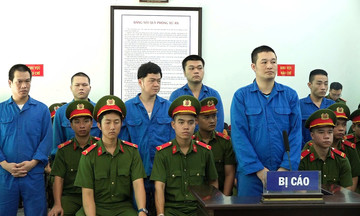Lawyer Luu Truong Han, 52, legal director of debt recovery for a bank, is authorized to handle hundreds of debt recovery lawsuits in various courts. Earlier this year, he filed approximately 100 lawsuits at the former District Court 1 (now District Court Area 1, Ho Chi Minh City). He was surprised to receive an email acknowledgment from the court only 3 days later. All subsequent court documents were also sent to him and the legal department via email.
When required to submit additional documents and evidence, Mr. Han was asked to send scanned copies instead of physical copies by mail. Once the case file was complete, he only had to bring the hard copy to the court once to pay the court fees, avoiding multiple trips as required previously.
 |
Nguyen Cao Tri, the creator of the e-court software, with thousands of family law case files from District Court Area 1 spanning the past 10 years, which are being digitized. Photo: Hai Duyen |
Nguyen Cao Tri, the creator of the e-court software, with thousands of family law case files from District Court Area 1 spanning the past 10 years, which are being digitized. Photo: Hai Duyen
District Court Area 1 is the first in the country to implement the e-court system for internal court management, a breakthrough in judicial reform and digital transformation. The entire process, from case acceptance to conclusion, is handled within a software platform integrating multiple applications – like a digital ledger containing all the data of a traditional court. This model was officially adopted at District Court 1 earlier this year and continues after the merger (of the former districts 1, 3, and 4 courts).
The model was developed by technology expert Nguyen Cao Tri, based on the court's practical needs, to apply technology to court operations.
Quoting General Secretary To Lam, "data is the lifeblood of digital transformation", Mr. Tri explained that to digitize court procedures, District Court Area 1 digitized all case files, documents, verdicts, decisions, and procedural documents, including newly received daily cases, pending cases, and old cases from 1976 to the present, totaling tens of millions of pages. This was achieved by scanning paper documents into digital files.
Citizens and litigants are provided individual access accounts, verified by biometrics and national ID cards, to file lawsuits. Upon logging in, they can track their case status, assigned judges, and any required supplementary documents. This contrasts sharply with the usual procedure, where litigants had to visit the court in person to check on their case status or if additional documents were needed.
Citizens and litigants receive individual access accounts, allowing them to track their cases "like tracking an online order". Video: Nguyen Cao Tri
All court documents have QR codes, allowing litigants to verify their authenticity at the citizen reception area using installed computers. After processing and digitization, case files are transferred to a database. The system randomly assigns cases to judges and notifies all parties via email. Judges can only access cases assigned to them.
Case handling requires no direct contact between litigants and clerks or judges. Case files are fully archived and can be copied or extracted even after case closure. "Full digitization is essential for judges and clerks to carry out procedural work online, accessing data anytime, anywhere, without paper," Mr. Tri said.
This e-court software allows judges, clerks, and court officials to log in using assigned accounts to process tasks, obtain document numbers, and sign and issue documents within the application. Document number management is synchronized to prevent duplication or discrepancies.
Court leaders can monitor judges' performance 24/7 through the e-court software, tracking their work efficiency and any interaction with case files. This allows for timely reminders and coordination, preventing case delays and ensuring timely issuance of documents as required by law. Monitoring can be done remotely, even when court leaders are traveling.
Thanks to initial digitization, the court can share data with the Procuracy, higher courts, or lawyers electronically, eliminating the need for printing and photocopying.
District Court Area 1 also uses litigation software for trials. All documents are prepared on the system and displayed publicly in the courtroom. Lawyers, prosecutors, and litigants have access and can interact directly on tablets: zooming, comparing, marking, or drawing on documents. Clerks manage evidence, preventing the release of unauthorized materials.
Leveraging its database, the e-court model incorporates internal AI, allowing judges to search documents by voice, summarize cases, and quickly find relevant legal texts. This is particularly helpful in complex cases with thousands of pages.
AI helps judges search documents by voice and summarize cases. Video: Nguyen Cao Tri
Mr. Han noted that since receiving the initial email notification, he could access the entire case file and track its progress via phone or computer anytime. In contrast, at other courts, after filing, he had to wait a week and rely on postal mail or personal visits to inquire about his case status. "I'm impressed by this improvement, saving us time and printing costs. All documents submitted are updated in the software, eliminating the need for paper copies even during trials," he said.
Similarly, lawyer Ngo Qui Linh (Director of Mai Dang Khang Law Firm), handling a case at District Court Area 1, received Zalo messages and scanned copies of court documents. The court also emailed links to download case-related documents, eliminating trips to the court for copies. "This method reduces document loss and delays compared to previous practices. It also allows litigants and lawyers to easily track case developments," Mr. Linh commented.
However, he noted that current procedural law still requires physical copies of case files and issued documents. For optimal convenience, online document exchange needs to be legally recognized.
 |
Nguyen Quang Huynh, Chief Justice of District Court Area 1, introduces the integrated e-court software. Photo: District Court Area 1 |
Nguyen Quang Huynh, Chief Justice of District Court Area 1, introduces the integrated e-court software. Photo: District Court Area 1
Overcoming time and space constraints is a key benefit of the e-court system. According to Nguyen Quang Huynh, Chief Justice of District Court Area 1, the court previously handled 250-300 cases monthly, a number that has increased significantly since merging with districts 3 and 4. The e-court model saves time and effort for both the court and citizens, reducing procedural delays.
"The e-court system makes the entire legal process transparent, from filing to verdict. Judges cannot directly contact litigants or interfere with case proceedings," Mr. Huynh stated.
The e-court model was designed to address time and space constraints. Judges and clerks no longer need to return to the main office for procedural tasks, even with multiple court locations. This foresight proved beneficial after the district court mergers.
From 1/7/2025, several legal changes, particularly regarding bankruptcy and intellectual property jurisdiction, took effect. These cases are now handled in 3 bankruptcy courts within district courts in Hanoi, Da Nang, and Ho Chi Minh City; and 2 intellectual property courts within district courts in Hanoi and Ho Chi Minh City. The digital court model significantly benefits litigants in other provinces, reducing travel for bankruptcy and intellectual property cases.
District Court Area 6 (merged from districts 7, Nha Be, and Can Gio), also implementing the e-court model, has addressed challenges arising from managing records from 3 former courts spread across 50 km. Dao Le Anh, Chief of Office at District Court Area 6, stated that the e-court model significantly aids management, especially procedural numbering, case assignment, incoming document processing, administrative document handling, and various other procedural activities, all performed digitally.
Citizens can file lawsuits at any location without needing to visit the main office, and judges and clerks can perform tasks remotely. "This allows our judges and clerks to conduct legal proceedings as prescribed, ensuring the merger doesn't cause delays in issuing legal documents or processing cases within statutory deadlines," Mr. Anh explained.
In recent years, both the Supreme People's Court and the Supreme People's Procuracy have prioritized digital transformation to enhance judicial efficiency, transparency, and reduce time and costs for citizens.
Following directives from the Supreme People's Court and the Ho Chi Minh City People's Court, in 11/2023, District Court Area 1 (then District Court 1) established a digitization team and pioneered the e-court software. After nearly two years of development and operation, judges and clerks now proficiently use the system, which has been transferred to District Court Area 6. Many other localities are preparing for implementation.
Hai Duyen












